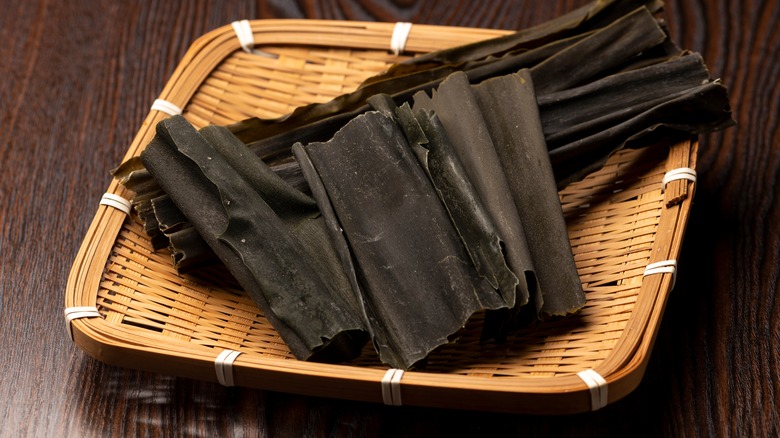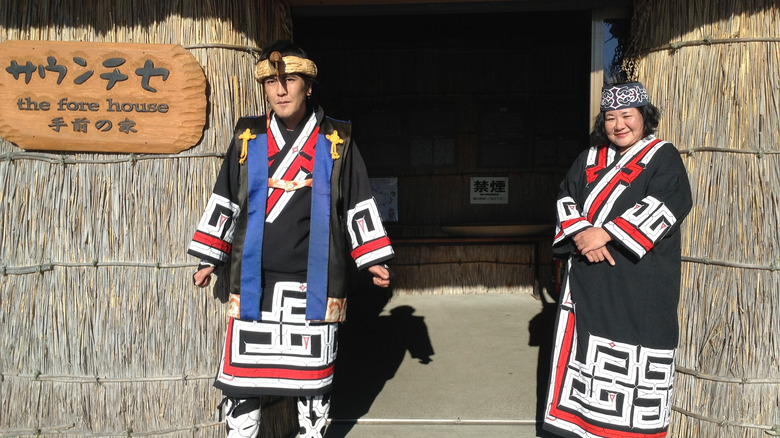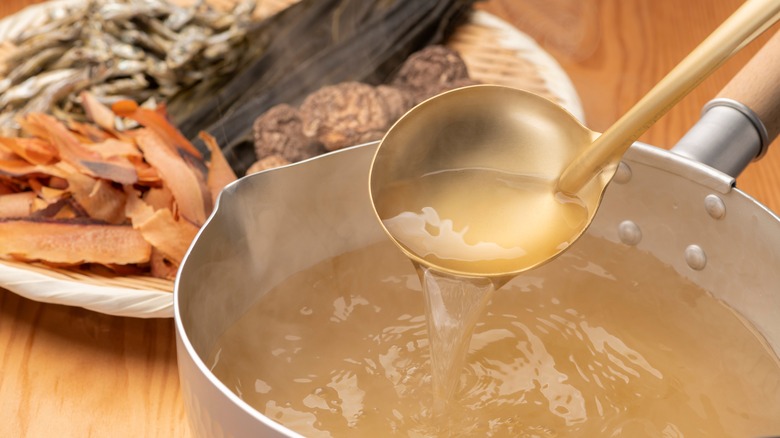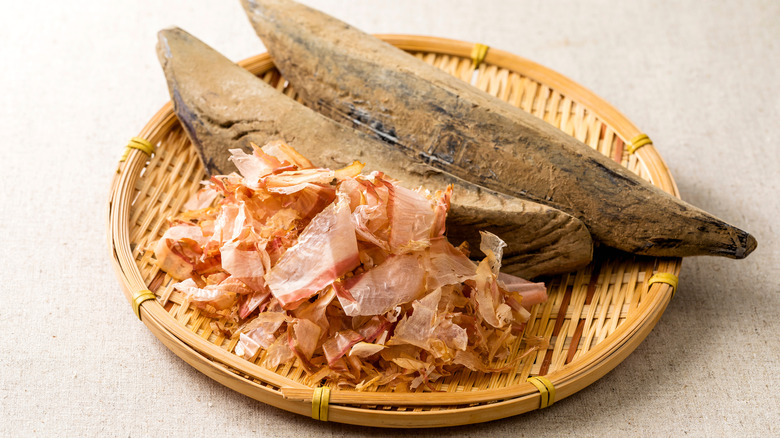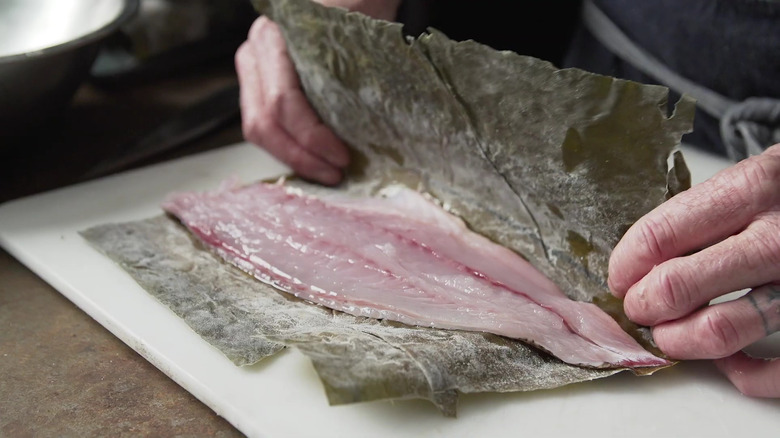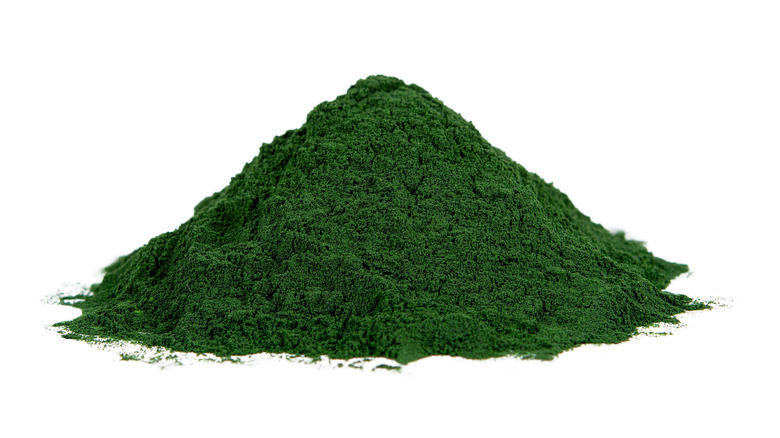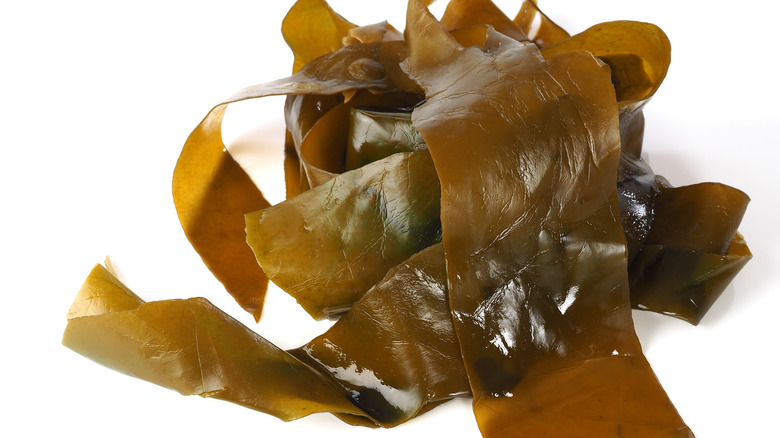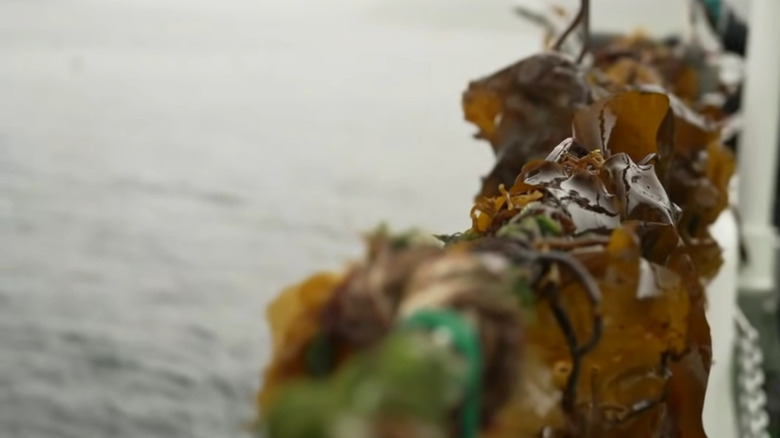Facts You Should Know About Kombu
We may receive a commission on purchases made from links.
Kombu — also known as kelp — is a type of edible seaweed that has formed an integral part of the Japanese diet for centuries, per The Fish Site. The sea vegetable's gentle presence is felt in many of the country's most famous dishes. It lends its delicate, umami-filled flavor to iconic Japanese culinary inventions, such as dashi, a broth that the Michelin Guide describes as the soul of Japanese food.
Japan owes its ubiquitous use of kombu to the Ainu, an Indigenous group that has lived on Hokkaido, Japan's northernmost island, for millennia (via BBC). Over the centuries, kombu steadily became more popular throughout the Japanese mainland and prefectures. Of course, the Ainu, and by extension Japan, are not the only culture that consumes kombu. However, BBC reports that seaweed's appearance in global diets and menus remains somewhat sparse.
This may have to change, given that global health crises and radical climate change have placed increased pressure on local and global food systems (per Met Office). During these turbulent times, kombu stands as a potential solution; it is highly nutritious, easily farmable, and extremely sustainable.
Kombu is an umbrella term for several kelp genus
As is often the case with plant names, the term kombu is used somewhat loosely. Contrary to common belief, the term does not refer to a single type of seaweed, but rather to a number of seaweed genus that have similar characteristics, per MasterClass.
It is also important to make the distinction between kombu and other types of seaweed that are popular in Japanese cuisine. One example is nori, which is a form of red algae with the genus Porphyra (via Britannica). Despite both of these being types of seaweed, the two are completely different products and should not be used interchangeably.
Britannica also reports that kombu, which goes by the scientific name of Laminaria, is a form of brown algae. There are around 30 types of kombu, all of which grow in colder seas as large seaweeds. While the majority of kombu share a number of characteristics, each type is unique. Consequently, every type of kombu has its own particular uses in the culinary setting. For example, rishiri-kombu comes from the far north of Hokkaido and is known as the kombu best-suited for making a flavorful dashi (per Umami Information Center).
It has been eaten for thousands of years
The Ainu are an Indigenous group that has lived on Hokkaido for thousands of years. BBC reports that the Ainu thrive by cultivating grains, hunting for local meat and fish, and gathering wild berries and plants. Kombu has always been an important part of the Ainu diet. According to Hokkaido Treasure Island Travel, the seaweed was likely coveted by the Ainu initially as a salt source, and then for its ability to make hearty broths. Studies of the remains of a settlement during the Jomon period, which was around 14,000 to 400 B.C., show evidence that the Ainu were eating kombu during that time.
The prevalence of kombu in the sea surrounding Hokkaido undoubtedly played a part in the popularity of this delicacy. In an interview with BBC, Ainu chef Hiroaki Kon said, "Ainu people only eat what is around them. They don't pick everything but think about the next year and the year after. They would always leave some part of the plant or tree so it could continue to grow."
Kombu spread throughout Japan during the Edo period
While kombu has been eaten by the Ainu for thousands of years, mainland Japan's love affair with the sea vegetable is relatively new. It began during the Muromachi period between 1336 and 1573 and became widespread throughout the Edo period, which took place from 1603 to 1867 (per SushiSushi).
The increased popularity of kombu in Japan came as a result of the new drying practices that were adopted during this time. This technique allowed kombu to be stored for long periods of time without spoiling, thus making it suitable for trade with mainland Japan (via Tofugu).
Kombu became a fixed part of Japanese culture throughout the Edo period and the Meiji era, as reported in Ann B. Irish's book "Hokkaido: A History of Ethnic Transition and Development on Japan's Northern Island". While this is partly attributed to the increased availability of kombu, the growth in its popularity is also thought to have been due to the colonization of Hokkaido. After occupying Hokkaido, the Japanese government soon realized that kombu could become an important source of income for their country. Consequently, they dominated the Ainu's trade and earned money by exporting to China and other countries.
It's a rich source of umami
Umami is known as the fifth taste and has a savory flavor that is both satisfying and satiating, per The Guardian. Umami's pleasing flavor profile is produced by three specific elements: inosinate, glutamate, and guanylate. These elements are vital to kombu because they have a synergistic effect and amplify the properties of one another. This, in turn, supercharges the umami experienced when eaten (via BioMed Research International). Processes, such as aging and fermentation, result in the creation of more glutamate, which explains why foods like katsuobushi are so packed with umami (via WebMD).
In comparison to fermented products, kombu contains high levels of glutamate in its natural state. This means it packs a powerful punch of umami whether it's fresh or processed (via Umami Information Center). The Umami Information Center also reports that kombu is one of the very few foods that contain not just one or two of the umami elements, but all three.
Okinawan cuisine relies heavily on kombu
Okinawa is a prefecture of Japan that consists of 150 islands in the East China Sea. This chain of islands has long been known for its extremely healthy population and has one of the highest concentrations of centenarians in the world (via World Economic Forum).
As on mainland Japan, kombu is an integral part of the Okinawan diet and has been linked to the longevity of the prefecture's population, as reported in the Journal of the American College of Nutrition. This was highlighted by Dr. Craig Willcox, professor of public health and gerontology at Okinawa International University, in an interview with The Guardian. "The Okinawans have a low risk of arteriosclerosis and stomach cancer, a very low risk of hormone-dependent cancers, such as breast and prostate cancer," explained Dr. Willcox. "They eat three servings of fish a week, on average ... plenty of whole grains, vegetables, and soy products too, more tofu and more kombu seaweed than anyone else in the world."
The prevalence of kombu in the Okinawan diet is somewhat surprising given that it cannot be grown by the prefectures and must be imported via China or Hokkaido (per Current Nutrition Reports). However, as stated by Dr. Willcox, seaweed is still widely used in Okinawan cuisine. Parts Unknown highlights that Okinawans use kombu to make dashi; however, it is also served with spare ribs in a dish called soki and can even be pickled and fried in tempura batter.
Kombu is one of three ingredients used to make dashi
As previously mentioned, kombu is one of the main ingredients used to make dashi, a delicious broth that defines Japanese cuisine. According to Michelin Guide, dashi is frequently made with monosodium glutamate (MSG) instead of kombu, as both provide umami. However, the difference in quality is telling and suggests that the quality of dashi, and thus the cuisine in general, depends on kombu.
Making good dashi can be as simple as soaking sheets of kombu in hot water. However, the very best dashi is made when kombu is combined with another umami-rich Japanese specialty — katsuobushi. Made from the shavings of skipjack tuna that has been dried, smoked, and fermented, katsuobushi adds an incredibly complex and intense smokiness to the delicate, oceanic flavor of kombu (via Great British Chefs).
Kombu can also be partnered with shiitake mushrooms to create a uniquely earthy dashi. This typo of broth would be closer to the original forms of dashi that were made in the early 17th century (via Great British Chefs).
It has many culinary uses outside of dashi
While its role in making dashi is a vital part of kombu's gastronomic and cultural importance, it is far from its only use in the culinary setting. The kelp is also used in a process called Kombujime, as noted by Tatler. With this technique, filets of fish are aged by pressing them between sheets of kombu for a number of days. Not only is the seaweed's umami imparted on the fish, but the filets also develop a waxy texture thanks to the presence of glutamate. The slow build-up of flavors creates an interesting scenario. Chef Max Levy explains: "We like strong flavors, and work hard not to serve fish on the day it comes, and to hold out as long as possible until it reaches the peak of its flavor."
Eat Japan reports that kombu can also be simmered with mirin and soy sauce to make tsukudani, a side dish frequently served with a bowl of plain rice. It can also be dried and combined with butter to use on vegetables, steaks, or lamb, per Sous Chef.
Finally, kombu is used to make tea (via CBC). This seaweed tea is known as kombucha; however, it is not the same drink as the fermented beverage that has become globally popular.
Kombu is available in many different forms
As kombu has become more popular around the world, demand for it in forms other than dried sheets has increased, as reported by Fortune Business Insights. Most notably, this has taken the form of powdered kombu, which can be sprinkled on dishes to add umami flavor (per Mara Seaweed). The seasoning is both healthy and tasty and can be used in rubs for brisket
Because both kombu and MSG contain glutamate, they can be used interchangeably. When MSG (wrongly) developed a bad reputation (via BBC), many restaurants began using powdered seaweed instead.
In an interview with Smithsonian Magazine, Adam Fleischman, founder of Umami Burger, explained why he prefers to use powdered kombu in his restaurant. "We didn't feel that using MSG was creative enough," he said. "We wanted to do it ourselves. By doing it ourselves, we could create a flavor that was umami without the stigma of MSG."
Kombu is also popular in liquid form. Concentrated dashi saves consumers the time and effort of making their own. The plant-based kombu dashi provides an intense flavor to stocks and sauces (via Sushi Sushi).
All types of kombu are highly nutritious
As reported by The Washington Post, kombu has many health benefits, thanks to the prevalence of important vitamins and minerals. The seaweed includes calcium, iodine, iron, and vitamins A and C.
Not only are these nutritional compounds present, but they are also found in high quantities. This is exemplified by iodine, a chemical element that aids thyroid function. On average, kombu contains 1,542 micrograms of iodine per gram when dried (via Thyroid Research). This means that 1 gram of kombu provides more than the recommended daily amount of iodine, per National Institutes of Health.
In addition to vitamins and minerals, kombu also contains sugars that are actually good for you. In an interview with Men's Health, Kim Yawitz, explained, "You might not think of sugar as being particularly healthy, but seaweed also contains specific types of sugar that are thought to improve health. For example, fucoxanthins and alginate are both types of sugar that appear to regulate blood sugar, while fucoidans are sugars that have been shown to reduce inflammation and boost the immune system."
Farming kombu is extremely sustainable
As reported by The Guardian, the 21st Century has already seen a number of food crises, and the prevalence of them is only expected to grow. Climate change, conflict, and population growth are all reasons behind this increased strain on global food systems, and many suggest that food shortages are going to become increasingly regular (per The Economist).
As such, there has been great interest in crops that may offer some relief to the current global situation. Seaweed, such as kombu, is one crop that has serious potential for several reasons. For one thing, commercial farming is environmentally friendly. As reported by Sustainable Food Trust, seaweed farms benefit the environment by fighting ocean acidification, filtering the ocean of excess nutrients, and absorbing carbon.
Seaweeds like kombu also grow extremely fast. This means with a little crop rotation, kombu can provide a reliable and healthy food source all year.
Underwater seaweed farms also benefit marine life, as highlighted by Hiroshi Sato in an interview with The Fish Site. "Seaweed production here is a good source of food for species like sea urchins," explained the ocean health activist. "The sea floor has become quite barren with no natural food for sea urchins. Anything that drops off the strings [that the seaweed grows on] is food for them."
Many cultures grow and consume kombu
While Hokkaido is undoubtedly the cultural home of kombu, production is becoming increasingly globalized. A report written by the Food and Agriculture Organization of the United Nations demonstrates this fact, stating that China is now the world's largest producer of kombu, with an annual total of 1.5 million tons (via Innovation Norway).
Korea is another large producer of kombu, with 25% of all seaweed produced by the nation being of this variety (via Fisheries and Aquatic Sciences). The same publication states that South Korea's capacity to grow kombu is increasing rapidly. In the 70s, 12,000 tons of seaweed were harvested annually; in 2017 that number had risen to 1,761,526 tons (via Algae).
While countries like South Korea and China are established producers and consumers of kombu, companies in other countries are beginning to promote it within their own populations. Many of these countries, such as Iceland, have an ancient history of seaweed consumption (per Visit Iceland). With consumers becoming more focused on sustainable, local products, new markets are emerging rapidly. As Gov.UK notes, the future of agricultural kombu looks bright.
Kombu aids in the digestion of beans and legumes
Aside from improving overall health and contributing to the restoration of the world's oceans, eating seaweed has one other benefit: It aids in the digestion of beans and legumes. Beans have a bad reputation for causing bloating and gastrointestinal issues in many people. These side effects are caused by raffinose, a carbohydrate that the body struggles to break down (via the International Foundation for Gastrointestinal Disorders).
However, The Washington Post reports that kombu can help facilitate the digestive process because it contains enzymes that break down raffinose. This addition is one that many chefs have been adopting, as Tom Hunt, a chef-patron at Poco, explained to Foodism. "If you want to make a super-flavored hummus, try adding a piece of kombu or kelp to your chickpeas when boiling them. It will enhance the flavor, and make them more digestible. You can also try this when making lentils or beans."
